volatility smile
description: implied volatility patterns that arise in pricing financial options
24 results
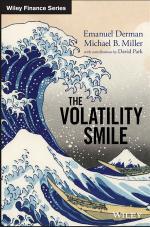
The Volatility Smile
by
Emanuel Derman,Michael B.Miller
Published 6 Sep 2016
While Figure 8.1 clearly resembles an actual smile, we saw in Chapter 1 that volatility smiles need not look anything like this. Volatility smiles can be flatter or more curved; they often look like smirks, rarely like frowns. No matter what their shape, it is common to refer to these functions and graphs as smiles. Figure 8.2 is a graph of the implied volatility smile for the S&P 500 for six-month expirations on two different dates, plotted as a function of moneyness. In both cases it is more of a smirk than a smile. Implied Volatility 20% 15% 10% 5% 0% 40 FIGURE 8.1 60 80 100 120 Strike Price Idealized Volatility Smile 140 160 133 The Smile Implied Volatility 30% 25% 20% 15% 10% 0.80 0.90 1.00 Strike/Index 12/31/2012 1.10 1.20 12/31/2015 FIGURE 8.2 S&P 500 Six-Month Volatility Smile Source: Bloomberg.
…
The difficulties of option valuation. An introduction to the volatility smile. Financial science and financial engineering. The purpose and use of models. INTRODUCTION Our primary aim in this book is to provide the reader with an accessible, not-too-sophisticated introduction to models of the volatility smile. Prior to the 1987 global stock market crash, the Black-Scholes-Merton (BSM) option valuation model seemed to describe option markets reasonably well. After the crash, and ever since, equity index option markets have displayed a volatility smile, an anomaly in blatant disagreement with the BSM model.
…
Using Equation 24.46 graph the approximate BSM implied volatility smile for strikes from $80 to $120. Epilogue There is no logical path to these laws; only intuition, resting on sympathetic understanding of experience, can reach them. —Albert Einstein n 1994, when researchers began attempting to explain the volatility smile, many of us hoped that there would be one better model that could replace Black-Scholes-Merton. Instead, we have ended up with a plethora of models, each of which, in its own way and under the right circumstances, can explain some aspects of the volatility smile. Some readers may find this lack of a single perfect model to be a disappointment.
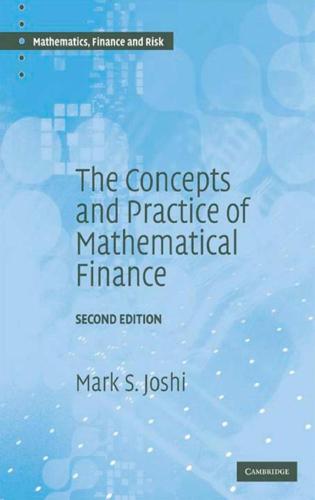
The Concepts and Practice of Mathematical Finance
by
Mark S. Joshi
Published 24 Dec 2003
The function Of has the correct boundary value by construction and since multiplication by f (1;) commutes with differentiation in the other variables, (16.26) is satisfied by Of. 398 Stochastic volatility We can now price any option for which we know the fundamental transform. We simply numerically invert the Fourier transform at the appropriate value of T and obtain a price. 16.6 Stochastic volatility smiles Since the possibility of stochastic volatility getting large increases the probability of large movements in the underlying stock, stochastic-volatility models lead to fatter tails for the distribution of the final stock price. This leads to implied-volatility smiles which pick up out-of-the-money; that is, smile-shaped smiles! If we allow correlation between the underlying and the volatility then a skew is introduced. Roughly, if the volatility and the underlying are negatively correlated then as the stock price falls, it becomes more volatile and so out-of-the-money put options require more hedging and thus are more valuable which leads to increased implied volatilities.
…
The sharpest smile is one year, and the shallowest is five years. Spot is 100 and jumps are asymmetric with mean ratio equal to 0.8. 18.3.2 Stochastic-volatility smiles If we use a stochastic-volatility model with constant parameters the model is of log-type and again everything is defined relative to the current value of spot and time, and we obtain a functional dependence for the implied volatility of the form &(S, K, t, T) _ &(K/S, T - t). (18.4) 18.3 Dynamics implied by models 417 0.25 0.2 0.15 0.1 0.05 0 Fig. 18.3. Stochastic-volatility smiles (Heston model) for time horizons of one through five years. The sharpest smile is one year, and the shallowest is five years.
…
(18.5) Smile dynamics and the pricing of exotic options 418 0.13 0.125 0.120.1150.11 0.105 0.1 0.095 0.090.0850.08 Fig. 18.4. Stochastic-volatility smiles (Heston model) for time horizons of one through five years. The sharpest smile is one year, and the shallowest is five years. Spot is 100 and volatility is uncorrelated with spot. The reversion speed is 1 and the volatility of variance is 0.1. Initial volatility is 10%. 0.14 0.13 0.12 0.11 0.1 0.090.080.07 -I 0.06 'O 6y '10 Ab 00 0h 00 0h X00 X20 'p' bO Fig. 18.5. Stochastic-volatility smiles (Heston model) for time horizons of two through ten years. The highest smile is two years, and the bottom is ten years.

Frequently Asked Questions in Quantitative Finance
by
Paul Wilmott
Published 3 Jan 2007
Journal of Finance 69 771-818 Wilmott, P 2006 Paul Wilmott On Quantitative Finance, second edition. John Wiley & Sons What is the Volatility Smile? Short Answer Volatility smile is the phrase used to describe how the implied volatilities of options vary with their strikes. A smile means that out-of-the-money puts and out-of-the-money calls both have higher implied volatilities than at-the-money options. Other shapes are possible as well. A slope in the curve is called a skew. So a negative skew would be a download sloping graph of implied volatility versus strike. Example Figure 2-9: The volatility ‘smile’ for one-month SP500 options, February 2004. Long Answer Let us begin with how to calculate the implied volatilities.
…
References and Further Reading What is the Finite-difference Method? References and Further Reading What is a Jump-Diffusion Model and How Does It Affect Option Values? References and Further Reading What is Meant by “Complete” and “Incomplete” Markets? References and Further Reading What is Volatility? References and Further Reading What is the Volatility Smile? References and Further Reading What is GARCH? References and Further Reading How Do I Dynamically Hedge? References and Further Reading What is Dispersion Trading? References and Further Reading What is Bootstrapping Using Discount Factors? References and Further Reading What is the LIBOR Market Model and Its Principal Applications in Finance?
…
Which numerical method should I use and when? 123 29. What is Monte Carlo Simulation? 132 30. What is the finite-difference method? 136 31. What is a jump-diffusion model and how does it affect option values? 142 32. What is meant by ‘complete’ and ‘incomplete’ markets? 146 33. What is volatility? 151 34. What is the volatility smile? 157 35. What is GARCH? 164 36. How do I dynamically hedge? 170 37. What is dispersion trading? 176 38. What is bootstrapping using discount factors? 179 39. What is the LIBOR Market Model and its principle applications in finance? 183 40. What is meant by the ‘value’ of a contract? 188 41.
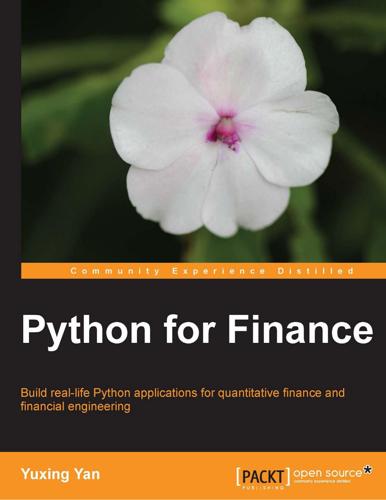
Python for Finance
by
Yuxing Yan
Published 24 Apr 2014
Rather than just presenting formulae that shows you how to estimate a portfolio's return and risk, the Python programs are given to download real-world data, form various portfolios, and then estimate their returns and risk including Value at Risk (VaR). When I was a doctoral student, I learned the basic concept of volatility smiles. However, until writing this book, I had a chance to download real-world data to draw IBM's volatility smile. [2] Preface What this book covers Chapter 1, Introduction and Installation of Python, offers a short introduction, and explains how to install Python and covers other related issues such as how to launch and quit Python. Chapter 2, Using Python as an Ordinary Calculator, presents some basic concepts and several frequently used Python built-in functions, such as basic assignment, precision, addition, subtraction, division, power function, and square root function.
…
The two output datasets with the Pandas' pickle format can be downloaded from http://canisius.edu/~yany/callsFeb2014.pickle and http://canisius.edu/~yany/putsFeb2014.pickle: from pandas.io.data import Options import datetime import pandas as pd def call_data(tickrr,exp_date): x = Options(ticker,'yahoo') data= x.get_call_data(expiry=exp_date) return data ticker='IBM' exp_date=datetime.date(2014,2,28) c=call_data(ticker,exp_date) print c.head() callsFeb2014=pd.DataFrame(c,columns=['Strike','Symbol','Chg','Bid','Ask', 'Vol','Open Int']) callsFeb2014.to_pickle('c:/temp/callsFeb2014.pickle') def put_data(tickrr,exp_date): x = Options(ticker,'yahoo') data= x.get_put_data(expiry=exp_date) return data [ 359 ] Volatility Measures and GARCH p=put_data(ticker,exp_date) putsFeb2014=pd.DataFrame(p,columns=['Strike','Symbol','Chg','Bid','Ask',' Vol','Open Int']) putsFeb2014.to_pickle('c:/temp/putsFeb2014.pickle') Volatility smile and skewness Obviously, each stock should possess just one volatility. However, when estimating implied volatility, different strike prices might offer us different implied volatilities. More specifically, the implied volatility based on out-of-the-money options, atthe-money options, and in-the-money options might be quite different. Volatility smile is the shape going down then up with the exercise prices, while the volatility skewness is downward or upward sloping.
…
Finance The put-call ratio The put-call ratio for a short period with a trend Summary Exercises [ vii ] 256 257 258 259 261 268 268 269 270 271 275 276 277 278 279 280 281 282 283 284 285 286 288 288 289 290 292 293 294 294 295 297 299 300 300 302 303 304 Table of Contents Chapter 11: Monte Carlo Simulation and Options Generating random numbers from a standard normal distribution Drawing random samples from a normal (Gaussian) distribution Generating random numbers with a seed Generating n random numbers from a normal distribution Histogram for a normal distribution 307 308 309 309 310 310 Graphical presentation of a lognormal distribution Generating random numbers from a uniform distribution Using simulation to estimate the pi value Generating random numbers from a Poisson distribution Selecting m stocks randomly from n given stocks Bootstrapping with/without replacements Distribution of annual returns Simulation of stock price movements Graphical presentation of stock prices at options' maturity dates Finding an efficient portfolio and frontier Finding an efficient frontier based on two stocks 311 312 313 315 315 317 319 320 322 324 324 Constructing an efficient frontier with n stocks Geometric versus arithmetic mean Long-term return forecasting Pricing a call using simulation Exotic options Using the Monte Carlo simulation to price average options Pricing barrier options using the Monte Carlo simulation Barrier in-and-out parity Graphical presentation of an up-and-out and up-and-in parity Pricing lookback options with floating strikes Using the Sobol sequence to improve the efficiency Summary Exercises 329 332 333 334 335 335 337 339 340 342 344 344 345 Impact of different correlations Chapter 12: Volatility Measures and GARCH Conventional volatility measure – standard deviation Tests of normality Estimating fat tails Lower partial standard deviation Test of equivalency of volatility over two periods Test of heteroskedasticity, Breusch, and Pagan (1979) Retrieving option data from Yahoo! Finance Volatility smile and skewness Graphical presentation of volatility clustering [ viii ] 326 347 348 349 350 352 354 355 358 360 362 Table of Contents The ARCH model Simulating an ARCH (1) process The GARCH (Generalized ARCH) model Simulating a GARCH process Simulating a GARCH (p,q) process using modified garchSim() GJR_GARCH by Glosten, Jagannanthan, and Runkle (1993) Summary Exercises Index [ ix ] 363 364 365 366 367 369 373 373 375 Preface It is our firm belief that an ambitious student major in finance should learn at least one computer language.
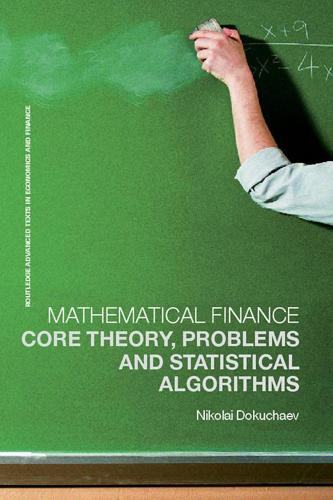
Mathematical Finance: Core Theory, Problems and Statistical Algorithms
by
Nikolai Dokuchaev
Published 24 Apr 2007
., when K~S(t)), and a larger error for in-the-money and outof-the-money options (i.e., the historical volatility is closer to the implied volatility when K~S(t)). In addition, different models for evolution of random volatility are often tested by comparing the shape of volatility smiles resulting from simulation with the volatility smile obtained from real market data. 7.2 Calculation of implied volatility By Lemma 7.3, any Black-Scholes price V(σ) for call or put is a monotonic increasing function in σ. An example of its shape is given in Figure 7.1. The code that creates this graph is given below.
…
In particular, the price of the call option with the strike price K and expiration time T is HBS,c(S(0), K, T, σ1, r)+(1−p)HBS,c(S(0), K, T, σ2, r). (7.6) Figure 7.2 represents the implied volatility calculated for this market using the code given below. It can be seen that even this very simple volatility model generates a volatility smile. Figure 7.2 Implied volatility, the market with random volatility from Example 5.63. It is assumed that (N, eps, s, T, r)=(24, 0.125, 2, 1, 0.1). © 2007 Nikolai Dokuchaev Mathematical Finance 138 MATLAB code for modelling of volatility smile (Example 5.63) function[v]=volsmile(N,eps,s,T,r) p=0.5; v1=0.3; v2=0.7; N1=100; eps1=1/100; v=zeros(1,N); op=v; K=v; K0=max(0.1, sN*eps/2); for k=1:N K(k)=K0+eps*k; op(k)=p*call(x,K(k),v1,T,r)+(1p)*call(x,K(k),v2,T,r); v(k)=impliedvol(N1,eps1,op(k),s,K(k),T,r); end; plot(K(1:N),v(1:N),'ro'); 7.4 Problems for two different stocks at time t=0, i=1, Problem 7.7 Assume that we observe prices 2.
…
In this case, we can conclude that the Black-Scholes model does not describe the real market perfectly, and its imperfections can be characterized by the gap between the historical and implied volatilities. Varying K and T gives different patterns for implied volatility. Similarly, the evolving price S(t) gives different patterns for implied volatility for different t for a given K. The most famous pattern is the so-called volatility smile (or volatility skew) that describes dependence of σimp on K. Very often these patterns have the shape of a smile (or sometimes skew). These shapes are carefully studied in finance, and very often they are used by decision-makers. They are considered to be important market indicators, and there are some empirical rules about how to use them in option pricing.
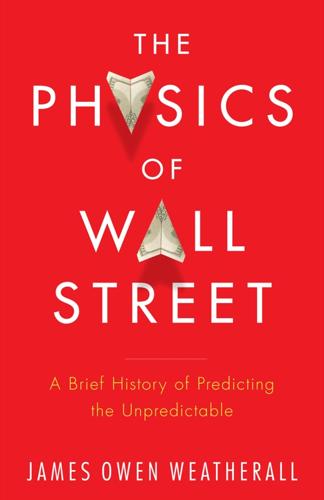
The Physics of Wall Street: A Brief History of Predicting the Unpredictable
by
James Owen Weatherall
Published 2 Jan 2013
These discrepancies are often called the volatility smile because of their distinctive shape in certain graphs. The smile appeared suddenly and presented a major mystery for financial engineers in the early 1990s, when its prevalence was first recognized. Notably, Emanuel Derman came up with a way of modifying the Black-Scholes model to account for the volatility smile, though he never came up with a principled reason why the Black-Scholes model had stopped working. Mandelbrot’s work, however, offers a compelling explanation for the volatility smile. One way of interpreting the smile is as an indication that the market believes large shifts in prices are more likely than the Black-Scholes model assumes.
…
During 1977 and 1978, Greenbaum, Struve, and a small team of proto-quants worked out a modified Black-Scholes model that took into account things like sudden jumps in prices, which can lead to fat tails. O’Connor was famously successful, first in options and then in other derivatives — in part because the modified Black-Scholes model tended to outperform the standard one. Remarkably, according to Struve, O’Connor was aware of the volatility smile from very early on. That is, even before the crash of 1987, there were small, potentially exploitable discrepancies between the Black-Scholes model and market prices. Later, when the 1987 crash did occur, O’Connor survived. There’s another, deeper concern about the market revolution initiated by Black and his followers that many people worried about in 1987 and that has become quite stark in the wake of the most recent crisis.
…
Sometimes assumptions that are usually excellent quickly become lousy as market conditions change. For this reason, the O’Connor story has an important moral. Many histories suggest that the 1987 crash rocked the financial world because it was so entirely unexpected — impossible to anticipate, in fact, given the prevailing market models. The sudden appearance of the volatility smile is taken as evidence that models can work for a while and then suddenly stop working, which in turn is supposed to undermine the reliability of the whole market-modeling enterprise. If models that work today can break tomorrow, with no warning and no explanation, why should anyone ever trust physicists on Wall Street?

Mathematics of the Financial Markets: Financial Instruments and Derivatives Modelling, Valuation and Risk Issues
by
Alain Ruttiens
Published 24 Apr 2013
From the data used for the previous volatility curve (S&P 500, ATM options), by using the above formula, we can compute the 3-month forward implied volatility after 6 months: the data are: spot 6-month volatility @ 18.56% spot 9-month volatility @ 18.86% giving (with 6 months and 9 months = 0.5 and 0.75 year respectively): 12.1.3 The volatility smile Stochastic models for underlyings are essentially based on the hypothesis of normal distribution of the log returns. This has proven a robust approach, and makes easier the calculations. A contrario, developing models based on a more general distribution presents: the difficulty of selecting what would be the adequate alternative distribution: this point is developed in Chapter 15, Section 15.1; the disadvantage that the kth moments are less and less stationary over time with k increasing (cf.
…
As a consequence, quoting an option may involve the determination of an implied volatility, which not only depends on the nature of the underlying and of the maturity of the option, but also of the spread between the strike price and the underlying spot price at that moment. The shape of the relationship such as on the graph explains why this feature has been called the “volatility smile”. If the actual distribution presents no fat tails, but some asymmetry, first, the market may well quote different implied volatility levels for calls and for puts, implying thus a kind of market consensus for a directional trend in the underlying evolution; second, the market can quote different implied volatilities for DOTM calls and DITM puts on the one hand, that is corresponding to lower underlying spot prices, than for DITM calls and DOTM puts on the other hand, corresponding to higher underlying spot prices.
…
Instead of starting from the process of the underlying spot as in Eq. 12.2, we start from a series of Ft forward underlying prices or rates, and the SABR model consists of the following system For a given instrument, the parameters α, β and ρ need to be calibrated on the corresponding volatility curve, that is, they must fit the market data, including observed options implied volatilities. In particular the SABR model allows for taking into account observed volatility smiles.7 As an alternative to the Heston and SABR models, let us also mention the one8 consisting – instead of starting from Eq. 12.3 – in considering the following relationship: that creates a third stochastic process Z3 that is independent (uncorrelated) with Z1. Provided some hypothesis can be reasonably made about ρ1, 2, presumably as a function of σt, the model allows for a Monte Carlo simulation.
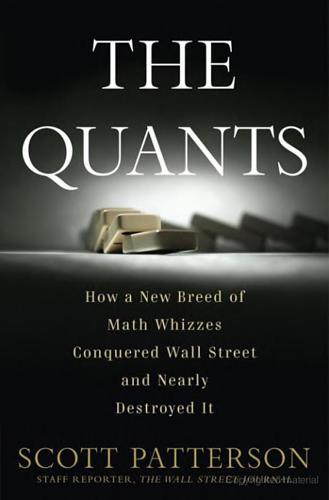
The Quants
by
Scott Patterson
Published 2 Feb 2010
Prices for deep out-of-the-money puts—long-shot bets on huge price declines—were unusually high, compared with prices for puts closer to the current price of the stock. Graphs of these prices displayed a curvy kink around such options that, according to the prevailing theory, shouldn’t exist. Traders soon came up with a name for this phenomenon: the “volatility smile.” It was the grim memory of Black Monday grinning sinisterly from within the very prices that underpinned the market. The volatility smile disobeyed the orderly world of “no arbitrage” laid out by Black-Scholes and modern portfolio theory, since it implied that traders could make a lot of money by selling these out-of-the-money puts. If the puts were too expensive for the risk they carried (according to the formula), the smart move would be to sell them hand over fist.
…
If the puts were too expensive for the risk they carried (according to the formula), the smart move would be to sell them hand over fist. Eventually that would drive the price down to where it should be. But, oddly, traders weren’t doing that. They were presumably frightened that another crash like Black Monday could wipe them out. They never got over the fear. The volatility smile persists to this day. The volatility smile perplexed Wall Street’s quants. For one thing, it made a hash of their carefully calibrated hedging strategies. It also raised questions about the underlying theory itself. “I realized that the existence of the smile was completely at odds with Black and Scholes’s 20-year-old foundation of options theory,” wrote Emanuel Derman, a longtime financial engineer who worked alongside Fischer Black at Goldman Sachs, in his book My Life as a Quant.
…
For Mom and Pop Contents The Players 1 ALL IN 2 THE GODFATHER: ED THORP 3 BEAT THE MARKET 4 THE VOLATILITY SMILE 5 FOUR OF A KIND 6 THE WOLF 7 THE MONEY GRID 8 LIVING THE DREAM 9 “I KEEP MY FINGERS CROSSED FOR THE FUTURE” 10 THE AUGUST FACTOR 11 THE DOOMSDAY CLOCK 12 A FLAW 13 THE DEVIL’S WORK 14 DARK POOLS Notes Glossary Acknowledgments The Players Peter Muller, outspokenly eccentric manager of Morgan Stanley’s secretive hedge fund PDT. A whip-smart mathematician who occasionally took to New York’s subways to play his keyboard for commuters, in 2007 Muller had just returned to his hedge fund after a long sabbatical, with grand plans of expanding operations and juicing returns even further.
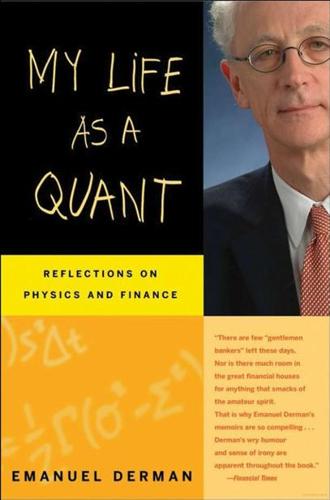
My Life as a Quant: Reflections on Physics and Finance
by
Emanuel Derman
Published 1 Jan 2004
Modeling mortgages Salomon's skill at quantitative marketing Mercifully laid off ■ CHAPTER 13 CIVILIZATION AND ITS DISCONTENTS 203 Goldman as home Heading the Quantitative Strategies Group Equity derivatives The Nikkei puts and exotic options Nothing beats working closely with traders Financial engineering becomes a real field CHAPTER 14 LAUGHTER IN THE DARK 225 The puzzle of the volatility smile Beyond Black-Scholes: the race to develop local-volatility models of options The right model is hard to find CHAPTER 15 THE SNOWS OF YESTERYEAR 251 Will Street consolidates Clothing goes casual Moving from equity derivatives to firmwide risk The bursting of the Internet bubble Taking my leave CHAPTER 16 THE GREAT PRETENDER 265 Full circle, back to Columbia Physics and finance redux ■ Different endeavors require different degrees of precision ■ Financial models as gedanken experiments Acknowledgments 271 About the Author 272 Index 273 MODELING THE WORLD If mathematics is the Queen of Sciences, as the great mathematician Karl Friedrich Gauss christened it in the nineteenth century, then physics is king.
…
Like stableboys who shut the barn door after the horse has bolted, investors who lived through the 1987 crash were now willing to pay up for future insurance against the risks they had previously suffered. By 1990 there were similar smiles or skews in all equity markets. Before 1987, in contrast, more light-heartedly naive options markets were happy to charge about the same implied volatility for all strikes, as illustrated by the dashed line in Figure 14.1. Figure 14.1 A typical implied volatility smile for three-month options on the Nikkei index in late 1994. The dashed line shows the lack of skew that was common prior to the 1987 crash. It was not only three-month implied volatilities that were skewed. A similar effect was visible for options of any expiration, so that implied volatility varied not only with strike but also with expiration.
…
Local volatility was an improvement on Black-Scholes in that it could account for the smile, but it had three genuine failings. First, our new model excluded the possibility that an index or stock could jump, and most market participants nowadays regard that possibility as the main factor determining the shape of the very short-term volatility smile. Our very first attempt to model the smile had indeed involved such jumps. We were never fond of jump models-since jumps are too violent and discontinuous to be hedged, when you include them you lose much of the coherence of the Black-Scholes model. But jumps are real, and omitting then made our model less realistic.
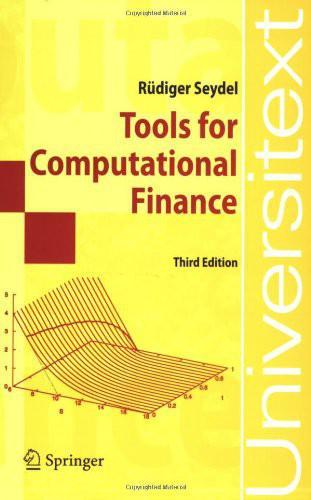
Tools for Computational Finance
by
Rüdiger Seydel
Published 2 Jan 2002
Adams: Sobolev Spaces. Academic Press, New York (1975). [AiC97] F. AitSahlia, P. Carr: American options: A comparison of numerical methods. In [RT97] (1997) p. 67-87. [AnA00] L. Andersen, J. Andreasen: Jump diffusion process: Volatility smile fitting and numerical methods for option pricing. Review Derivatives Research 4 (2000) 231-262. [AB97] L.B.G. Andersen, R. Brotherton-Ratcliffe: The equity option volatility smile: an implicit finite-difference approach. J. Computational Finance 1,2 (1997/1998) 5–38. [AnéG00] T. Ané, H. Geman: Order flow, transaction clock, and normality of asset returns. J. of Finance 55 (2000) 2259-2284.
…
Calculate the implied volatilities for the data T − t = 0.211 , S0 = 5290.36 , r = 0.0328 Exercises 55 and the pairs K, V from Table 1.3 (for more data see www.compfin.de). Enter for each calculated value of σ the point (K, σ) into a figure, joining the points with straight lines. (You will notice a convex shape of the curve. This shape has lead to call this phenomenon volatility smile.) Table 1.3. Calls on the DAX on 4. Jan 1999 K V 6000 80.2 6200 47.1 6300 35.9 6350 31.3 6400 27.7 6600 16.6 6800 11.4 Exercise 1.6 Price Evolution for the Binomial Method For β from (1.11) and u = β + β 2 − 1 show " ! √ " ! u = exp σ ∆t + O (∆t)3 . Exercise 1.7 Implementing the Binomial Method Design and implement an algorithm for calculating the value V (M ) of a European or American option.
…
There the forward approach is known as explicit Euler method and the backward approach as implicit Euler method. on Section 4.3: Crank and Nicolson suggested their approach in 1947. Theorem 4.4 discusses three main principles of numerical analysis, namely order (of convergence), stability, and efficiency. A Crank-Nicolson variant has been developed that is consistent with the volatility smile, which reflects the dependence of the volatility on the strike [AB97]. Notes and Comments 175 In view of the representation (4.12) the Crank-Nicolson approach corresponds to the ODE trapezoidal rule. Following these lines suggests to apply other ODE approaches, some of which lead to methods that relate more than two time levels.

Analysis of Financial Time Series
by
Ruey S. Tsay
Published 14 Oct 2001
(6.25) 6.9 JUMP DIFFUSION MODELS Empirical studies have found that the stochastic diffusion model based on Brownian motion fails to explain some characteristics of asset returns and the prices of their derivatives (e.g., the “volatility smile” of implied volatilities; see Bakshi, Cao, and Chen, 1997, and the references therein). Volatility smile is referred to as the convex function between the implied volatility and strike price of an option. Both out-ofthe-money and in-the-money options tend to have higher implied volatilities than at-the-money options especially in the foreign exchange markets. Volatility smile is less pronounced for equity options. The inadequacy of the standard stochastic diffusion model has led to the developments of alternative continuous-time models.
…
A formal definition also requires that X t be a right-continuous homogeneous Markov process with left-hand limit. In this section, we discuss a simple jump diffusion model proposed by Kou (2000). This simple model enjoys several nice properties. The returns implied by the model are leptokurtic and asymmetric with respect to zero. In addition, the model can reproduce volatility smile and provide analytical formulas for the prices of many options. The model consists of two parts, with the first part being continuous and following a geometric Brownian motion and the second part being a jump process. The occurrences of jump are governed by a Poisson process, and the jump size follows a double exponential distribution.
…
C. (1997), Options, Futures, and Other Derivatives, 3rd ed. Prentice-Hall: Upper Saddle River, New Jersey. Kessler, M. (1997), “Estimation of an ergodic diffusion from discrete observations,” Scandinavian Journal of Statistics, 24, 1–19. Kou, S. (2000), “A jump diffusion model for option pricing with three properties: Leptokurtic feature, volatility smile, and analytic tractability,” working paper, Columbia University. Lo, A. W. (1988), “Maximum likelihood estimation of generalized Ito’s processes with discretely sampled data,” Econometric Theory, 4, 231–247. Merton, R. C. (1976), “Option pricing when the underlying stock returns are discontinuous,” Journal of Financial Economics, 5, 125–144.

Market Risk Analysis, Quantitative Methods in Finance
by
Carol Alexander
Published 2 Jan 2007
We therefore require a b and c such that the quadratic fx = ax2 + bx + c passes through the points f0 25 = 0 205 f0 50 = 0 18 f0 75 = 0 195 This leads to the equations a + 4b + 16c = 16 × 0 205 a + 2b + 4c = 4 × 0 18 9a + 12b + 16c = 16 × 19 5 In the spreadsheet for this example we find the solution a = −0 320 b = −0 340 c = 0 270 Figure I.5.8 plots the fitted implied volatility smile and from this we can read off the interpolated values of the 10-delta and the 90-delta volatilities as 23.9% and 22.3%, respectively. In general, fitting the quadratic fx = ax2 + bx + c through three points, f0 25 = 25 f0 50 = 50 f0 75 = 75 gives the following solution for the coefficients: ⎛ ⎞ ⎛ ⎞−1 ⎛ ⎞ a 1 4 16 1625 ⎝b⎠ = ⎝1 2 4 ⎠ ⎝ 450 ⎠ c 9 12 16 1675 Numerical Methods in Finance 197 28.0% 27.0% 26.0% 25.0% 24.0% 23.0% 22.0% 21.0% 20.0% 19.0% 18.0% 17.0% 0 0.1 0.2 0.3 0.4 0.5 0.6 0.7 0.8 0.9 1 Figure I.5.8 Fitting a currency smile But when only three implied volatilities are available a quadratic interpolation tends to underestimate the market quotes at more extreme delta values.
…
In general, fitting the quadratic fx = ax2 + bx + c through three points, f0 25 = 25 f0 50 = 50 f0 75 = 75 gives the following solution for the coefficients: ⎛ ⎞ ⎛ ⎞−1 ⎛ ⎞ a 1 4 16 1625 ⎝b⎠ = ⎝1 2 4 ⎠ ⎝ 450 ⎠ c 9 12 16 1675 Numerical Methods in Finance 197 28.0% 27.0% 26.0% 25.0% 24.0% 23.0% 22.0% 21.0% 20.0% 19.0% 18.0% 17.0% 0 0.1 0.2 0.3 0.4 0.5 0.6 0.7 0.8 0.9 1 Figure I.5.8 Fitting a currency smile But when only three implied volatilities are available a quadratic interpolation tends to underestimate the market quotes at more extreme delta values. Hence readers are recommended to use the vanna–volga interpolation method described in Castagna and Mercurio (2007). If further data on 10-delta strangles and risk reversals are available, two more points can be added to the implied volatility smile: 10 = 50 + ST10 + 21 RR10 90 = 50 + ST10 − 21 RR10 (I.5.13) A more precise interpolation and extrapolation method is then to fit a quartic polynomial to the ATM, 25-delta and 10-delta data: this is left as an exercise to the reader. I.5.3.3 Cubic Splines: Application to Yield Curves Spline interpolation is a special type of piecewise polynomial interpolation that is usually more accurate than ordinary polynomial interpolation, even when the spline polynomials have quite low degree.
…
I.5.3.3 Cubic Splines: Application to Yield Curves Spline interpolation is a special type of piecewise polynomial interpolation that is usually more accurate than ordinary polynomial interpolation, even when the spline polynomials have quite low degree. In this section we consider cubic splines, since these are the lowest degree splines with attractive properties and are in use by many financial institutions, for instance for yield curve fitting and for volatility smile surface interpolation. We aim to interpolate a function fx using a cubic spline. First a series of knot points x1 xm are fixed. Then a cubic polynomial is fitted between consecutive knot points. We denote by Ci x the cubic polynomial in the segment xi xi+1 , and joining these together gives the spline function: ⎧ ⎪ C x x ∈ x1 x2 ⎪ ⎨ 1 Sx = ⎪ ⎪ ⎩C x x ∈ x x m−1 m−1 m 198 Quantitative Methods in Finance Various conditions are imposed.
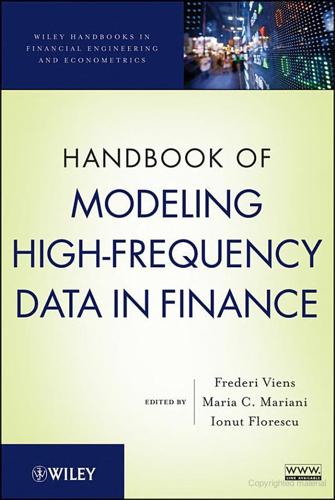
Handbook of Modeling High-Frequency Data in Finance
by
Frederi G. Viens
,
Maria C. Mariani
and
Ionut Florescu
Published 20 Dec 2011
Chapter Eight Parameter Estimation and Calibration for Long-Memory Stochastic Volatility Models A L E X A N D R A C H RO N O P O U LO U INRIA, Nancy, France 8.1 Introduction It has been observed that there exists a discrepancy between European option prices calculated under the Black and Scholes (1973) model with constant volatility and the market-traded option prices. In general, the volatility exhibits an intermittent behavior with periods of high values and periods of low values. As a result, implied volatilities at market prices are not constant across a range of options, but vary with respect to strike prices and create the so-called volatility smile (or smirk). Stochastic volatility models were introduced in order to model this observed random behavior of the market volatility. Under such a model, the volatility is described by a stochastic process. Among the first models in the literature were these by Taylor (1986) and Hull and White (1987), under which the volatility dynamics are described by an Ornstein–Uhlenbeck process.
…
Published 2012 by John Wiley & Sons, Inc. 219 220 CHAPTER 8 Estimation and calibration for LMSV (1994), Heston (1993), and Scott (1987) whereas a presentation of properties, option pricing techniques, and statistical inference methods can be found in the book by Fouque et al. (2000a). It is widely believed that volatility smiles can be explained to a great extent by stochastic volatility models. However, it has been well documented that volatility is highly persistent, which means that even for options with long maturity, there exist pronounced smile effects. Furthermore, a unit root behavior of the conditional variance process is observed, particularly when we work with high frequency data.
…
Risk neutral stochastic volatility model. Int J Theor Appl Finance 1998;1(2):289–310. 15. Berestycki H, Busca J, Florent I. Computing the implied volatility in stochastic volatility models. Commu Pure and Appl Math 2004;57(10):1352 –1373. 16. Andersen L, Andreasen J. Jump-diffusion processes: volatility smile fitting and numerical methods for option pricing. Rev Deriv Res 2000;4:231–262. 17. Cont R, Tankov P. Financial modelling with jumps processes. CRC Financial mathematics series. Chapman & Hall, Boca Raton, Florida; 2003. References 381 18. Florescu I. Stochastic volatility stock price: approximation and valuation using a recombining tree. sharp estimation of the almost sure lyapunov exponent estimation for the anderson model in continuous space.
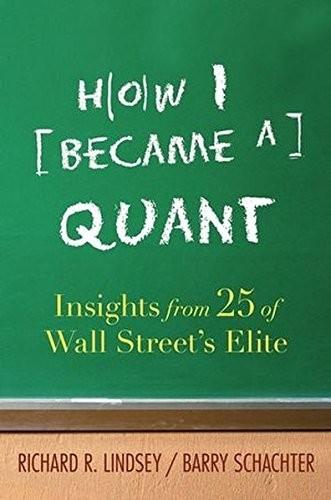
How I Became a Quant: Insights From 25 of Wall Street's Elite
by
Richard R. Lindsey
and
Barry Schachter
Published 30 Jun 2007
First in Goldman Sachs Quantitative Strategies Research Notes, January 1994, “The Volatility Smile and Its Implied Tree,” Derman and Kani, and then later in a paper called “Riding on a Smile,” Risk, 7, no. 2 (1994), pp. 32–39. This paper and many of Derman’s other papers are available from his website, www.ederman.com. JWPR007-Lindsey 348 May 18, 2007 11:41 note s 18. This was also published twice. First in Goldman Sachs Quantitative Strategies Research Notes, February 1996, “Implied Trinomial Trees of the Volatility Smile,” Derman, Kani, and Chriss, and then in a paper by the same name published in the Summer 1996 in the Journal of Derivatives. 19.

Traders, Guns & Money: Knowns and Unknowns in the Dazzling World of Derivatives
by
Satyajit Das
Published 15 Nov 2006
Options where the strike was a long way away from the DAS_C07.QXP 8/7/06 198 4:45 PM Page 198 Tr a d e r s , G u n s & M o n e y current price (deep in-the-money or deep out-of-the-money options) seemed to be priced using a higher volatility. Researchers built complex models incorporating the volatility ‘surface’ with an embedded volatility ‘smile’ to price these options. You will remember how NatWest misplaced their ‘smile’, losing tens of millions of pounds in the process. The volume of option pricing research from academics and quants in investment banks reached pandemic proportions. It was the age of proceduralism. Ever-increasing computer power and the demand for fast solutions for complex products drove a shift to mechanical application of procedure.
…
The investor’s initial investment was guaranteed. The investor got a return based on the average performance of a basket of six stocks. At specific intervals, the best performing stock in the basket would be removed from the basket for future periods. Dealers chuckled about selling volatility, volatility smiles, trading correlation within the basket and taking on forward volatility and correlation risks. Platoons of quants crunched numbers to price and hedge the structures. Did the investor understand what they were buying? They voted with their money. They bought the stuff in large licks. Large fund managers steered clear in the main.
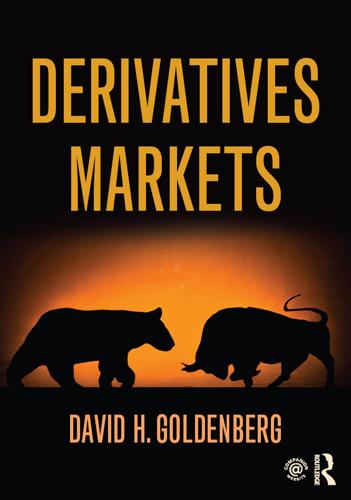
Derivatives Markets
by
David Goldenberg
Published 2 Mar 2016
If σ is constant, then it is also constant across options with different exercise prices and σIV should not depend upon which exercise price K is used to estimate it. This turns out not to be empirically true, at least since the market crash of 1987, and it generates a volatility smile, and its variations. A vast literature has developed around explaining volatility smiles and its variations. We can’t cover that here, but we can look at the economic reasons for expecting σ not to be a constant. 16.8 NON-CONSTANT VOLATILITY MODELS 16.8.1 Empirical Features of Volatility Some of the general empirical features that imply some degree of volatility predictability are clustering (persistence),which means that periods of high (low) volatility seem to persist, and reversion to the mean, which means that too high (too low) volatility seems to correct itself by moving back to the normal, long-run average level.
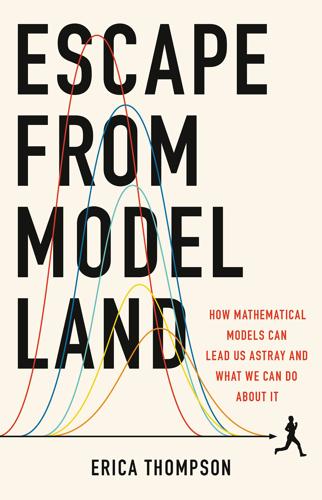
Escape From Model Land: How Mathematical Models Can Lead Us Astray and What We Can Do About It
by
Erica Thompson
Published 6 Dec 2022
The Black–Scholes model returns a constant volatility for any strike price of an option (the strike price is the price at which the option can be exercised, i.e., the pre-agreed price at which the buyer has an option to buy or sell). Before 1987, this was enforced (or performed, to use MacKenzie’s word) by the traders themselves assuming the correctness of the model. After 1987, rather than a flat line, a ‘volatility smile’ emerged on plots of implied volatility, tipping upwards for options further away from the central price. That means that the equation is wrong, i.e., that the price no longer supports an assertion that changes will be log-normally distributed in future. Deviations from flatness – a ‘smile’, ‘smirk’ or ‘skew’ – suggest different judgements being made about the way the stock will behave in future.

A Primer for the Mathematics of Financial Engineering
by
Dan Stefanica
Published 4 Apr 2008
If the lognormal assumption were true, then the implied volatilities corresponding to all these options should be equal. However, this does not happen. Usually, the implied volatility of either deep out of the money or deep in the money options is higher than the implied volatility of at the money options. This phenomenon is called the volatility smile. Another possible pattern for implied volatility is the volatility skew, when, e.g., the implied volatility of deep in the money options is smaller than the implied volatility of at the money options, which in turn is smaller than the implied volatility of deep out of the money options. We restrict our attention to solving the problem (8.66) corresponding to the call option, i.e., with the function f(x) given by (8.67), using Newton's method.
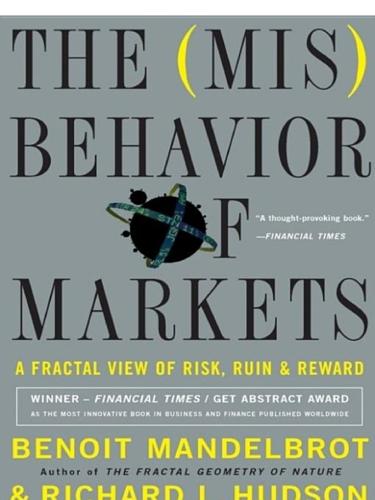
The Misbehavior of Markets: A Fractal View of Financial Turbulence
by
Benoit Mandelbrot
and
Richard L. Hudson
Published 7 Mar 2006
The “strike” price at which each contract can be exercised is on the bottom scale; the volatility that the Black-Scholes formula infers from the data is on the vertical scale, in standard deviations. If the formula were right, there would be nothing much to see: just one flat line. Improving or replacing Black-Scholes is one of the liveliest subdisciplines in mathematical finance. The most common approach is to try merely fixing the old formula. Software to correct the “volatility smile,” the U-shaped pattern that Black-Scholes volatility errors often trace on graph paper, is now standard. Many adopt the GARCH methods mentioned earlier; while these produce better results than Black-Scholes alone, they are still not accurate. Some approaches mix ideas similar to mine with those of others.
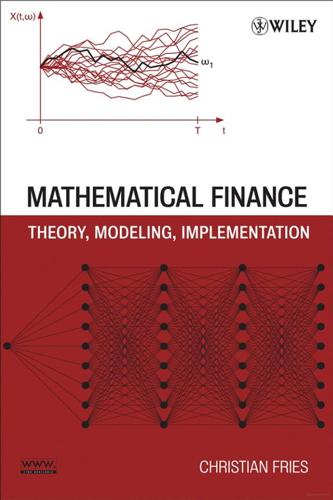
Mathematical Finance: Theory, Modeling, Implementation
by
Christian Fries
Published 9 Sep 2007
Journal of Business 51(4), 621?651, 1978. [51] B, P; B, M; G, P: Monte Carlo methods for security pricing. Journal of Economic Dynamics and Control, 21, 1267-1321 (1997). [52] B, D; M, F; R, F: Lognormalmixture dynamics and calibration to market volatility smiles. 2000. http: //www.damianobrigo.it [53] B, M; G, P: Estimating Security Price Derivatives using Simulation. Management Science, 1996, Vol. 42, No. 2, 269-285. [54] B, M; G, P: Pricing American-Style Securities by Simulation. J. Econom. Dynam. Control, 1997, Vol. 21, 1323-1352. 426 This work is licensed under a Creative Commons License. http://creativecommons.org/licenses/by-nc-nd/2.5/deed.en Comments welcome. ©2004, 2005, 2006 Christian Fries Version 1.3.19 [build 20061210]- 13th December 2006 http://www.christian-fries.de/finmath/ BIBLIOGRAPHY [55] C, J F.: Valuation of Early-Exercise Price of Options Using Simulations and Nonparametric Regression.
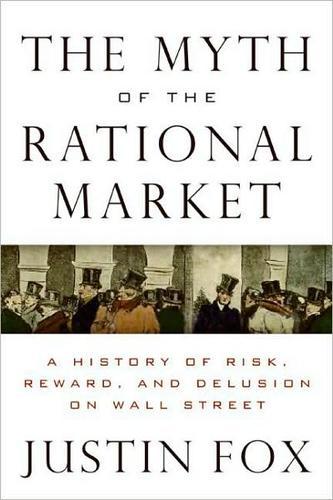
The Myth of the Rational Market: A History of Risk, Reward, and Delusion on Wall Street
by
Justin Fox
Published 29 May 2009
The universe has only existed an estimated 12 billion years; the New York Stock Exchange was, as of October 1987, 170 years old.13 Either stock market investors were desperately, spectacularly, unimaginably unlucky that October day, or the bell curve did not come remotely close to representing the true nature of financial market risk. This realization came quickly to some options traders. After October 19, options prices displayed what came to be called a “volatility smile.” By turning the Black-Scholes equation around, one can calculate the implied volatility of any stock from the price of its options. Put options allow one to sell a share of stock at a preset price. After the 1987 crash, put options that were well out of the money (the stock was at $40, say, and the put allowed one to sell it for $10) traded at prices that, according to Black-Scholes, implied a similar crash every few years.
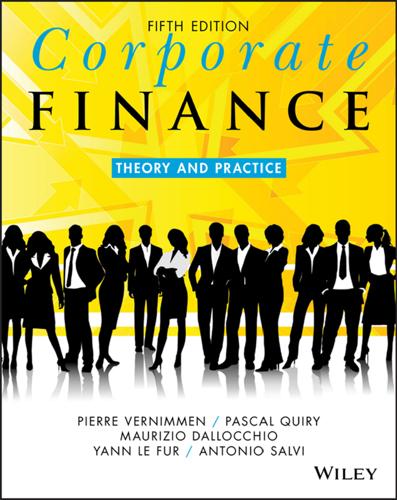
Corporate Finance: Theory and Practice
by
Pierre Vernimmen
,
Pascal Quiry
,
Maurizio Dallocchio
,
Yann le Fur
and
Antonio Salvi
Published 16 Oct 2017
When we determine the implied volatility of an underlying asset (the only factor not likely to be observed directly) based on the price of various options having the same underlying asset, we can see that we do not find a single figure. Hence, the implied volatility on options far out-of-the-money or far in-the-money is higher than the implied volatility recalculated on the basis of at-the-money options. This phenomenon is called the volatility smile (because when we draw volatility on a chart as a function of strike price, it looks like a smile). We will see in the following chapters the many applications of options in corporate finance: to raise financing (see Chapter 25); to resolve conflicts between management and ownership or between ownership and lenders (see Chapter 34); to hedge risks and invest (see Chapter 50); to choose investments (see Chapter 30); to value assets (see Chapter 31); to value the equity of a company (see Chapter 34); to take over a company (see Chapter 44).
…
unitranch debt unlevered beta (beta assets) unlimited companies unlisted companies unsolicited offers unwinding of contracts US income statement formats US listings, non-US companies US-style options “used” financial products validation of deliveries valuation errors effects valuation/valuation methods annuity/perpetuity comparison of consolidated accounts cost of capital equity inventories overview P/E principle reconciling differences shareholders’ equity volatility young companies value capital employed corporate governance finance creating future contracts illustration implications organisation theories and tax shield taxation and theoretical foundation values distinction value added value additivity rule value of assets value chain value of company, distributing value creation criteria internal financing investment choice limitations M&A deals markets in equilibrium measuring NPV equal to postponed projects real estate uncertainty working capital value dating value of debt see also value of net debt value of equity capital structure enterprise value equation of methods multiples based on options theory reinvested cash flow value of equity capital value of flexibility value of hybrids convertible bonds mandatory convertibles preference shares warrants value of investments value investors value of net debt value of option binomial method intrinsic value at maturity parameters real options risk time value volatility value at risk (VaR) value of security capital markets cost of capital falling/rising financial manager’s role financial markets maximising risk/fluctuation yield curves value stocks value transfer, bankruptcy value in use values–value distinction VaR see value at risk variable costs, breakeven point variable-income securities variance analysis risk-analysis volatility and VDD see vendor due diligence vega vendor due diligence (VDD) venture capital funds venture capitalists shareholders’ agreement valuing young companies vertical integration vesting period, stock options veto power, blocking minority viability of company Vishny, R. visibility volatility behavioural finance capital employed debt securities investment risk options and price speculative valuation underlying asset value of option volatility risk volatility smile volume growth volumes/volume effects financial market restrictions gross margin liquidity measured in terms of voluntary offers voting caps, shareholders voting rights bondholders capital structure consolidated accounts one share one voting right shareholder structure shares vulture funds WACC see weighted average cost of capital waivers, debt issue warehousing (nominee) agreements warranties warrants defensive measures definition existing shareholders practical uses restructuring plans share buy-backs shareholder position theoretical analysis value watchlist, rating agencies weak-form efficient market wealth additions to creation deductions from dividends modifying weighted average cost of capital (WACC) see also cost of capital weighted average cost method weighted average PVI “white knight” takeover bids wide-capitalisation market indexes Wilson formula work in progress working capital aspects of calculating capital expenditures case study changes in definition evaluating financing investment in managing nature of non-operating operating turnover ratios workshop model organisation write-backs write-downs year-to-year change, working capital yield curves yield of dividends yield to earnings yield of energy yield to maturity yield stocks young companies see start-ups Z-scores zero balance account (ZBA) zero cash zero-coupon bonds zero-coupon loans zero net debt zero NPV zero-sum game Zeta score WILEY END USER LICENSE AGREEMENT Go to www.wiley.com/go/eula to access Wiley’s ebook EULA.
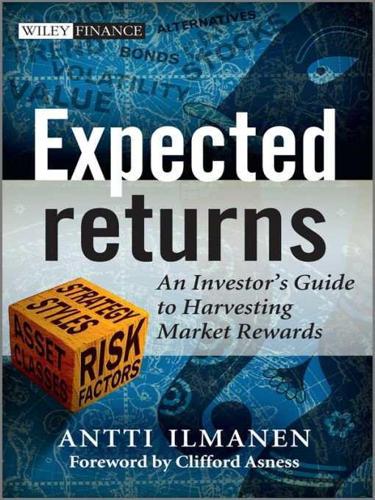
Expected Returns: An Investor's Guide to Harvesting Market Rewards
by
Antti Ilmanen
Published 4 Apr 2011
By market convention, implied volatilities are often quoted based on the B-S formula and reflect its underlying assumptions. Unequal B-S implied volatilities across strike prices (smile or smirk) may be interpreted as market recognition of prevalent non-normalities and other deviations from B-S assumptions. A symmetric volatility smile could be explained by fat tails in the real-world asset return distribution; while an asymmetric skew/smirk could be explained by greater downside volatility (the market’s greater propensity to jump downwards rather than upwards). Since the 1987 equity market crash, the skew for equity index options has been so extreme that investor preferences likely have contributed to it.

Stigum's Money Market, 4E
by
Marcia Stigum
and
Anthony Crescenzi
Published 9 Feb 2007
This volatility should be constant regardless of the terms of any options that are written on it. However, it is an empirical fact that the implied volatilities of in-the-money and out-of-the-money options are typically higher than the implied volatilities of at-the-money options. This is known as the volatility smile. Typically, the implied volatility also depends on other characteristics of the option such as its maturity. SHORTCOMINGS OF BLACK-SCHOLES One of the failures of the Black-Scholes formula—an empirical one—is discussed above. Empirically, we cannot match all the prices of options on an underlying stock by using a single volatility for the underlying stock.